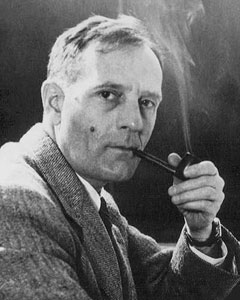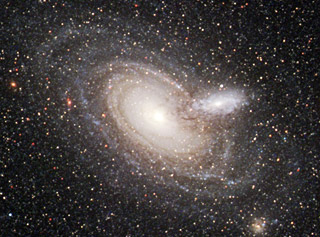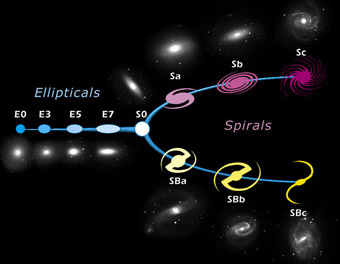
Edwin Hubble
1889 - 1953
Discovered the existence of galaxies outside our own Milky Way galaxy.
Observed that galaxies move faster away from us as their distance increases, proving that the universe is expanding.
Considered one of the most important observational cosmologists of the 20th century.
Edwin Hubble was born in Marshfield, Missouri in 1889. His father was an insurance executive and his family moved to Wheaton, Illinois the following year. 1898, his family moved to Chicago where he attended high school. In his younger days, Hubble was a gifted athlete who enjoyed a number of sports including baseball, football, and basketball. He also ran track in both high school and college. Hubble was also an excellent student who had a fond interest in science. He was a big fan of science fiction authors such as Jules Verne and Henry Rider.

galaxies. (Hubble Public Domain Image)
In 1906, Hubble received a scholarship to the University of Chicago. During this time he concentrated his studies on mathematics, astronomy, and philosophy. In 1910, he received a bachelor of science degree in mathematics and astronomy. He attended Oxford University on a Rhodes scholarship. His mother did not approve of his astronomy studies, so he chose instead to study law. He graduated three years later and returned to the United States in 1913. He was admitted to the bar and set up a small law practice in Louisville, Kentucky. He soon realized that he wasn't happy as a lawyer and accepted a teaching position at New Albany High School in New Albany, Indiana. He taught Spanish, physics, and mathematics for a year before deciding that his true calling was astronomy. He studied at Yerkes Observatory at the University of Chicago. He received his doctorate in astronomy in 1917. His thesis was titled, Photographic Investigations of Faint Nebulae.
While studying for his doctorate, Hubble was invited to join the staff at the Mount Wilson Observatory in Pasadena, California. But this prestigious position would have to wait. Congress declared war on Germany and Hubble rushed his dissertation for his PhD so he could volunteer for the United States Army. He joined and was assigned to the 86th Division. He rose to the rank of Major, but his division never saw combat. After the end of World War I he spent a year in Cambridge where he continued to study astronomy. When he returned to the United States, he accepted the position at the Mount Wilson Observatory. He was given access to the newly completed Hooker telescope, which at the time was the largest telescope in the world. At this time, most astronomers believed that the entire universe consisted of only our local Milky Way galaxy. Hubble used the new telescope to observe stars known as Cepheid variables in several fuzzy objects known as nebulae. His observations proved that these nebulae were too far away to be located in the Milky Way. These nebulae were actually galaxies located outside our own galaxy. With this one great discovery, the universe became a whole lot bigger.

(Wikipedia Public Domain Image)
The discovery that our Milky Way was just one of many galaxies in the universe shook the astronomical community. But this was just the beginning. Hubble began to classify galaxies into groups according to their appearance. This arrangement became known as the Hubble sequence. Hubble continued to study galaxies and eventually started to look at the spectra of their emitted light. He noticed that the red light shifted as their distance increased. He noticed that this redshift increased as the galaxy's distance increased. This meant that the galaxies were all moving away from us. It also proved that the farther away a galaxy was, the faster it was moving. This relationship of a galaxy's distance and speed is now known as Hubble's Law.
Hubble continues to work at Mount Wilson Observatory until World War II broke out. He left to serve in the war, but realized he could do more for the war effort as a scientist. he worked at the Aberdeen Proving Grounds in Maryland and received the Medal of Merit for his service. After the war, he returned to Mount Wilson. He continued to work at Mount Wilson and Mount Palomar until he suffered a stroke at the age of 63, he dies on September 28, 1953. His work revolutionized the field of astronomy. By showing that other galaxies existed, scientists for the first time were able to grasp the enormous size of our universe. In addition to the Medal of Merit, he also received the Franklin Medal for physics, the Legion of Merit, the Bruce Medal, and the Gold Medal from the Royal Astronomical Society. Sadly, he never won a Nobel prize since there was no category for astronomy at the time. NASA honored his legacy by naming the Hubble Space Telescope after him. He is remembered to this day as one of the world's greatest astronomers.




